Content
Finding domains and ranges
The natural domain of a function is the set of all allowable input values. We will call it the domain of the function \(f\), denoted by \(\mathrm{domain}(f)\). The range of the function \(f\) is the set of all possible output values: \[ \mathrm{range}(f) = \{\, f(x) : x\in\mathrm{domain}(f) \,\}. \]For a particular function \(f(x)\), determining \(\mathrm{domain}(f)\) and \(\mathrm{range}(f)\) is sometimes quite complicated.
Example
What is the domain and range of the function \(f(x)=4-x^2\)?Solution
Here a graph of the function helps.
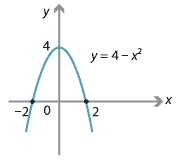
Example
What is the domain and range of \(f(x)=-\dfrac{7}{x}\)?Solution
The graph of \(y=f(x)\) is a rectangular hyperbola.
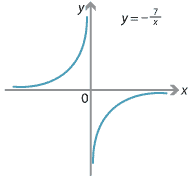
Example
What is the domain and range of \(f(x)=7^x-5\)?Solution
This is a vertical translation of an exponential function.

Example
What is the domain and range of \(f(x)=\sqrt{16-x^2}\)?
Solution
We have \begin{align*} y = \sqrt{16-x^2} \ &\iff\ y^2 = 16-x^2 \hspace{4mm}\text{and}\hspace{4mm} y \geq 0 \\ &\iff\ x^2+y^2=16 \hspace{4mm}\text{and}\hspace{4mm} y \geq 0. \end{align*}So the graph of \(f(x)\) is the top half of the circle with centre the origin and radius 4.
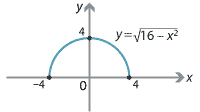
Hence, \(\mathrm{domain}(f) = [-4,4]\) and \(\mathrm{range}(f) = [0,4]\).
In the next example, we find the domain and range without first drawing the graph.
Example
Find the domain and range of \(f(x)=\sqrt{1-2x}\).
Solution
We first find the domain of \(f(x)\):
\begin{align*} f(x) \text{ is defined} \ &\iff\ 1-2x \geq 0 \\ &\iff\ x \leq \tfrac{1}{2}. \end{align*}So \(\mathrm{domain}(f) = (-\infty,\dfrac{1}{2}]\).
Every non-negative real number can be obtained as a value of \(f(x) = \sqrt{1-2x}\). Thus \(\mathrm{range}(f) = [0,\infty)\).
We can sketch the graph of this function by noticing that
\begin{align*} y = \sqrt{1-2x} \ &\iff\ y^2 = 1-2x \hspace{4mm}\text{and}\hspace{4mm} y \geq 0 \\ &\iff\ x = \tfrac{1}{2}(1 - y^2) \hspace{4mm}\text{and}\hspace{4mm} y \geq 0. \end{align*}So this is 'half' of a rotated and translated parabola.
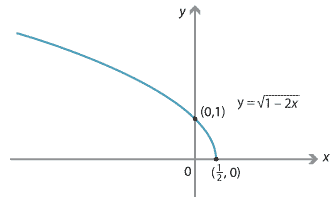
Example
Find the domain and range of \(f(x)=x^{\frac{1}{3}}\). Sketch the graph of \(y=f(x)\).
Solution
Clearly \(\mathrm{domain}(f) = \mathbb{R}\), since all real numbers have a cube root. As \(x\to \infty\), \(f(x)\to\infty\) and as \(x\to -\infty\), \(f(x)\to -\infty\). Since \(f\) is continuous, it follows that \(\mathrm{range}(f) = \mathbb{R}\).
We have \(y=x^{\frac{1}{3}}\) if and only if \(x=y^3\). The graph of \(y=x^3\) is as follows.
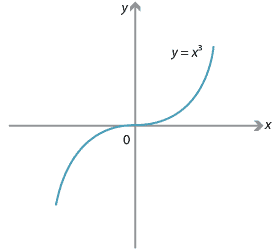
The graph of \(x=y^3\), or \(y=x^\frac{1}{3}\), is obtained by reflecting in the line \(y = x\).
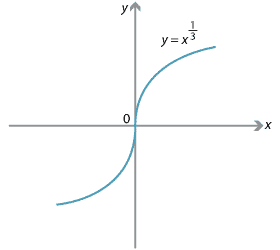
Example
Find the domain and range of \(f(x)=|x|\), where as usual
\[ |x| = \begin{cases} -x &\text{if } x < 0, \\ x &\text{if } x \geq 0. \end{cases} \]Solution
By drawing the graph of \(y=|x|\), we see that \(\mathrm{domain}(f) = \mathbb{R}\) and \(\mathrm{range}(f) = [0,\infty)\).
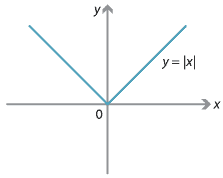
Exercise 5
Let \(\lfloor x\rfloor\) denote the largest integer less than or equal to \(x\). So, for example, \(\lfloor \pi \rfloor=3\).
- Let \(f(x) = \lfloor x \rfloor\). Sketch the graph of \(y=f(x)\). Find \(\mathrm{domain}(f)\) and \(\mathrm{range}(f)\).
- Let \(g(x) = x - \lfloor x \rfloor\). Sketch the graph of \(y=g(x)\). Find \(\mathrm{domain}(g)\) and \(\mathrm{range}(g)\).
(In some books, the notation for \(\lfloor x\rfloor\) is \([x]\).)
